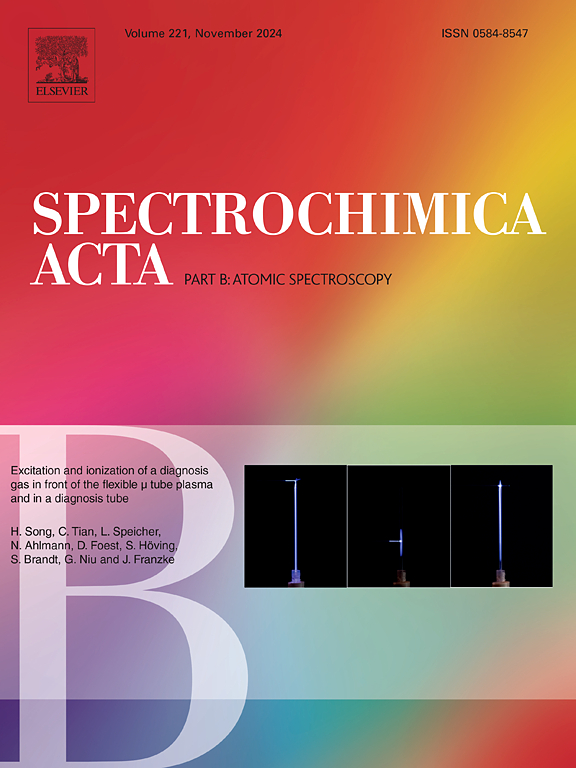Quantitative analysis of dysprosium in coated NdFeB used magnets by laser-induced breakdown spectroscopy for sorting prior to recycling
IF 3.2
2区 化学
Q1 SPECTROSCOPY
引用次数: 0
Abstract
Permanent magnets containing strategic rare earth elements (REE) such as Nd, Pr or Dy are being used more and more around the world, and their recycling is becoming a major stake in a context of virtual monopoly of China on the production of REEs. This paper addresses the sorting of solid used NdFeB magnets upstream of a recycling process. Dysprosium was chosen as representative of heavy REEs, and the LIBS technique was selected to perform online quantitative analysis under a residual coating or oxidation layer when present.
The studies were carried out using two different LIBS systems. The first one was a commercial laboratory equipment with a short-range working distance of 30 cm. Laser ablation conditions were optimized based on the LIBS signal intensity and stability, on the shot-to-shot signal evolution, and on the quality of the calibration curve. This led to 60 pre-ablation shots and 40 analysis shots. Under these conditions, we showed the feasibility of quantifying the dysprosium content under a depth of 35 to 60 μm with a relative uncertainty of less than 10 % at 95 % confidence.
The second LIBS system was a homemade setup designed to make measurements at 1 m distance, a working range representative of a possible online implementation above a conveyor belt. The ablation efficiency of this system was found much too low, but it was considerably increased by using the laser in the free-running mode. In the standard Q-switched mode, the results also showed the feasibility of quantifying dysprosium with uncertainties of the same order than with the short-range equipment.

求助全文
约1分钟内获得全文
求助全文
来源期刊
CiteScore
6.10
自引率
12.10%
发文量
173
审稿时长
81 days
期刊介绍:
Spectrochimica Acta Part B: Atomic Spectroscopy, is intended for the rapid publication of both original work and reviews in the following fields:
Atomic Emission (AES), Atomic Absorption (AAS) and Atomic Fluorescence (AFS) spectroscopy;
Mass Spectrometry (MS) for inorganic analysis covering Spark Source (SS-MS), Inductively Coupled Plasma (ICP-MS), Glow Discharge (GD-MS), and Secondary Ion Mass Spectrometry (SIMS).
Laser induced atomic spectroscopy for inorganic analysis, including non-linear optical laser spectroscopy, covering Laser Enhanced Ionization (LEI), Laser Induced Fluorescence (LIF), Resonance Ionization Spectroscopy (RIS) and Resonance Ionization Mass Spectrometry (RIMS); Laser Induced Breakdown Spectroscopy (LIBS); Cavity Ringdown Spectroscopy (CRDS), Laser Ablation Inductively Coupled Plasma Atomic Emission Spectroscopy (LA-ICP-AES) and Laser Ablation Inductively Coupled Plasma Mass Spectrometry (LA-ICP-MS).
X-ray spectrometry, X-ray Optics and Microanalysis, including X-ray fluorescence spectrometry (XRF) and related techniques, in particular Total-reflection X-ray Fluorescence Spectrometry (TXRF), and Synchrotron Radiation-excited Total reflection XRF (SR-TXRF).
Manuscripts dealing with (i) fundamentals, (ii) methodology development, (iii)instrumentation, and (iv) applications, can be submitted for publication.

 求助内容:
求助内容: 应助结果提醒方式:
应助结果提醒方式:


